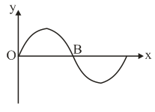Displacement Relation for a Progressive Wave
Displacement Relation for a Progressive Wave: Overview
This Topic covers sub-topics such as Intensity of Waves, General Wave Equation, Intensity of Sound Waves, Pressure Equation of Sound Wave, Sinusoidal Waves in Solids and Liquids and, Relation between Pressure and Displacement Amplitudes
Important Questions on Displacement Relation for a Progressive Wave
The transverse displacement of a wave on a string is given by . This represents a
Equation of a wave motion (with t in second and x in metre) is given by, . The velocity of the wave is given by :
A wave of amplitude , velocity and wavelength is travelling along positive -axis, then the correct expression for the wave is
The equation of a progressive wave is The wavelength of the wave is,
The clocktower ("ghantaghar") of Dehradun is famous for the sound of its bell, which can be heard, albeit faintly, upto the outskirts of the city away. Let the intensity of this faint sound be The clock is situated high. The intensity at the base of the tower is:-
The equation of a wave travelling on a string is where are in and in second. The velocity of the wave is
The figure below shows the wave at any instant travelling in the -direction. What is the magnitude of the slope of the curve at :

A sensor is exposed for time to a lamp of power placed at a distance . The sensor has a circular opening that is in diameter. Assuming all energy of the lamp is given off as light, the number of photons entering the sensor if the wavelength of light is is :-
A progressive wave is represented by
Where all the observations are in MKS system. The wave velocity will be -
The transverse wave shown is travelling from right to left in a medium. The direction of the instantaneous velocity of a particle of the medium at point is

A travelling wave is partly reflected and partly transmitted from a rigid boundary. Let and be the amplitude of the incident wave, reflected wave and transmitted wave and and be the corresponding intensities. Then choose the correct alternatives.
A longitudinal standing wave, is maintained in a homogeneous medium of density . Here is the angular speed and k, the wave number and a is the amplitude of the standing wave. This standing wave exists all over a given region of space.
If a graph E (= EP + EK) versus t, (i.e.,) total space energy density versus time were drawn at the instants of time t = 0 and , between two successive nodes separated by distance which of the following graphs correctly shows the total energy (E) distribution at the two instants.
A longitudinal standing wave, is maintained in a homogeneous medium of density . Here is the angular speed and k, the wave number and a is the amplitude of the standing wave. This standing wave exists all over a given region of space.
The space density of the kinetic energy K.E = EK (x, t) at the point (x, t) is given by
For next three question please follow the same
A longitudinal standing wave, is maintained in a homogeneous medium of density . Here is the angular speed and k, the wave number and a is the amplitude of the standing wave. This standing wave exists all over a given region of space.
The space density of the potential energy P.E.= EP (x, t) at a point (x, t) in the space is
A harmonically moving transverse wave on a string has a maximum particle velocity and acceleration of 3 m/s and 90 m/s2 respectively. Velocity of the wave is 20 m/s. Find the waveform.
The energies E1 and E2 of two radiations are 25 eV and 50 eV respectively. The relation between their wavelengths, i.e., will be
If pressure amplitude in a sound wave is changed from to . The percentage increase in the intensity of wave is
Select the correct statment about the two mechanical waves, and , propagate in a medium with the same speed.
The motion of particles of a wave at and are given by the following equations respectively. (displacement is in )
and
Find the wave velocity.
